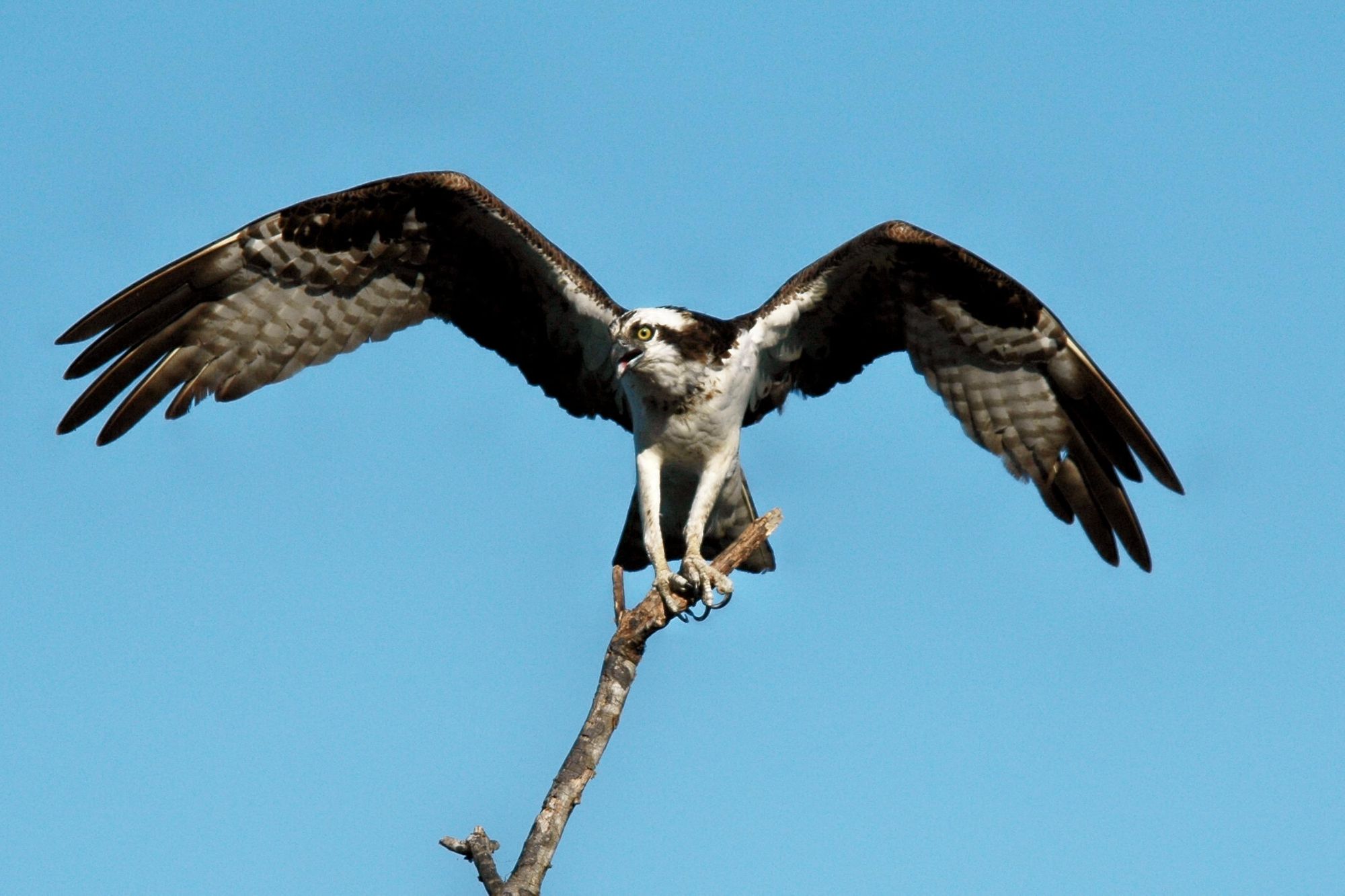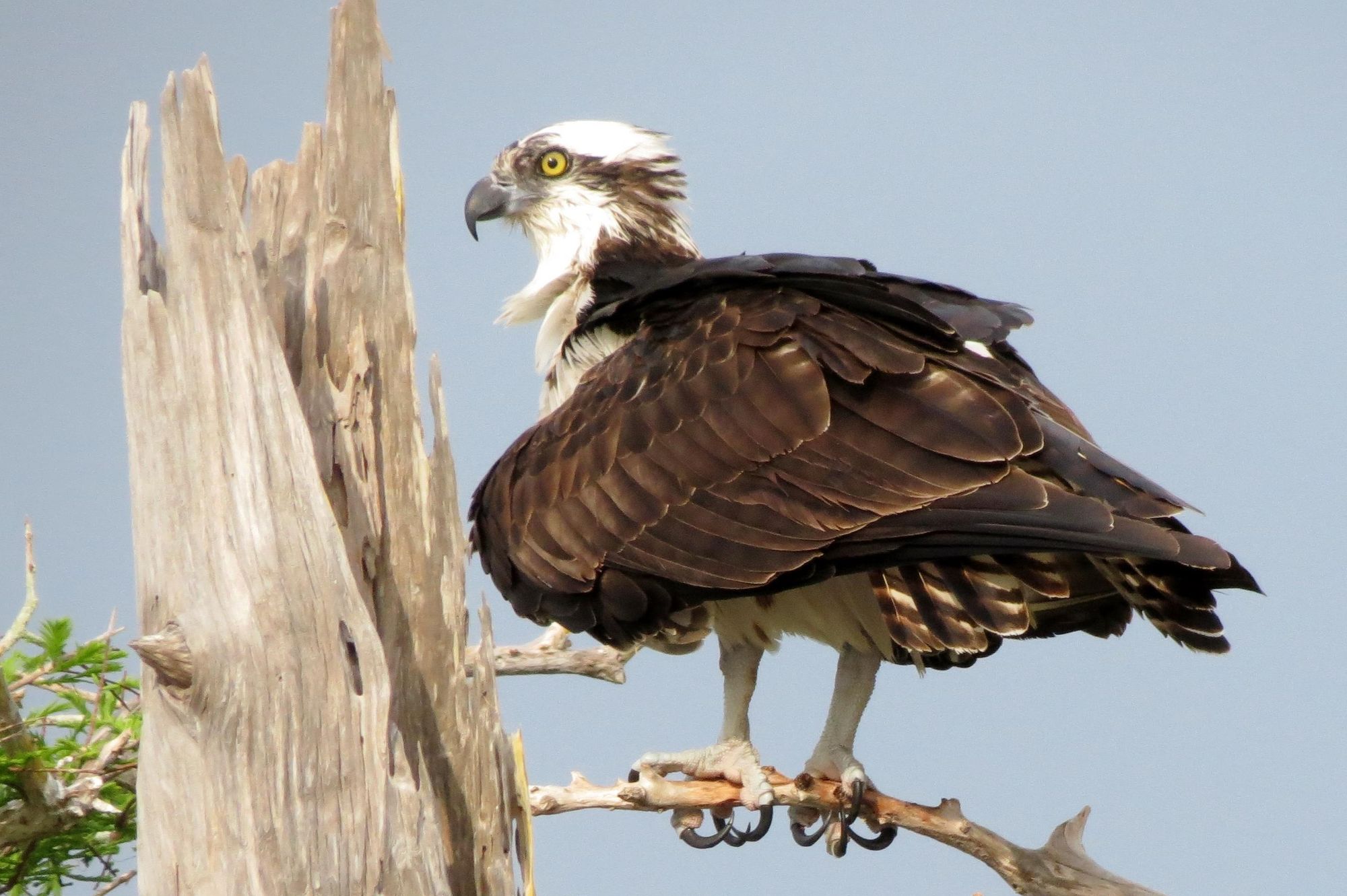Good Times:
by: Sherri Leigh Smith
...Ospreys in the St Lawrence Region.
The theme of last month's article on aerial insectivores was a bit of a downer. The reality of wildlife declines, resulting from human causes, always depresses me. So this month it seems appropriate to celebrate a species that is doing fabulously in our region and throughout most of North America. The Osprey, or fish Eagle and the Bald Eagle,"THE" real fish Eagle, are poster children for 20th century conservation success. Both species are likely as numerous locally as any time since the American Civil War.

The nineteenth century was a terrible time to be any wildlife species on our continent. Firearms technology had greatly improved and very few species were protected. From Bison to Bald Eagles to tiny Blackpoll Warblers, any moving wild animal was a potential target. While Osprey and Bald Eagle were technically safe in some states, this status was rarely recognized by yahoo so-called “sportsman “ or every farm boy with a gun. At Hawk Mountain, and other shooting stands along the Pennsylvania mountain ridges, protected species, such as Osprey, were slaughtered with impunity until well into the Great Depression.
Although poorly documented locally, undoubtedly shooting mortality depressed populations of large conspicuous raptors for decades. By the mid-twentieth century better protection in both New York and Ontario, as well as improving attitudes toward raptors, reduced shooting, although limited losses continue to the present. Just as these birds began to catch a break, along came the next killer threat to their survival; DDT contamination. Most readers are aware of how fish eating birds were impacted by chemical bioaccumulation that caused egg shell thinning and reproductive failure. Thus, this new insidious threat to Osprey populations more than made up for any population gains resulting from reduced shooting.

Thus, as the 1970s dawned, breeding Ospreys were very uncommon in much of our region. The Indian River Lakes Area had one of the best remaining small nesting populations in all of upstate New York. Pairs inhabiting small lakes there, and in similar situations on the Canadian side, were subjected to much less pesticide contamination from agricultural runoff than those on big water. Even though these birds were being contaminated on migration and their wintering grounds nesting at relatively “clean” sites reduced their overall exposure. Thus, some of these pairs continued to produce young. This small population no doubt contributed mightily to the regional renaissance to come.
Renaissance is probably a great understatement. Beginning by the early 1990s, Osprey populations began to explode. Today this species is clearly the most common and obvious large bird of prey on the St. Lawrence River from early April to mid-October. Breeding pairs are widely distributed, and their bulky nests adorn utility poles, navigation buoys, occasional trees and other suitable structures throughout . Reproductive success is more than adequate to continue to grow the population with most pairs raising 2-3 young per season. It’s a bully time to be an Osprey or an Osprey watcher on the big river!



Photos by Bill Munro ©
To what do we raptor enthusiasts owe this plethora of good news? First: once in a while our species actually gets it right with a decision. My first conservation war was over DDT, and although it took a decade, this evil creation of mankind was banned for use in the US by the mid 1970s. The threshold levels of this chemical on the landscape were already dropping by 1980, when the tentative first signs of population recovery began for several impacted birds of prey. No DDT ban, no 2020 river Ospreys; simple as that.
An old adage in conservation, however, states that while we win battles we never quite seem to win the war. Proof of this regarding impacts of these chemicals on birds of prey is readily found on the Internet. Put “DDT raptors “ into your search engine and within the first twenty results there will be sites claiming raptor population declines never occurred and DDT is really a wonderful panacea for humankind while advocating its return to use. Absolutely disgusting, but not surprising in an era when incontrovertible science is treated as just somebody’s opinion by many, including by those in high public office.

Luckily, when DDT in the environment receded and levels in the tissues of female Ospreys dropped below where viable eggs could be produced, the picture was increasingly rosy. Combined with improved public appreciation for all raptors that was being fostered by the growing nature education and environmental movements, the species future prospects were assured. In addition, a relatively high reproductive rate, for a large raptor, and tolerance of nesting near humans didn’t hurt their long -term prospects. Also, good remaining habitat quality and Ospreys being relatively tolerant of nesting near each other(small territory size) made a comeback inevitable.
So, will future generations of River Rats get to enjoy interacting with this fun species? In the near term, up until 2050, I would say yes. I anticipate no looming killer threats to their well-being locally. The nesting population will be limited by factors such as available nest sites, food supply and others. The explosive population growth of the last thirty years should slow dramatically, as the species approaches the area’s carrying capacity for Ospreys . My impression is it’s already slowing. Interactions with increasing Bald Eagle populations for nest sites and food availability, are among the factors that will control their population. Ironically, this once threatened species is impacting the threatened Common Tern population by nesting above tern colonies located on navigation cells. Since these colonies are critical to tern populations, we humans have to intervene on their side, and encourage these Osprey pairs to find alternative nursery sites.
Beyond 2050, the future of Ospreys here is less clear. While they are an adaptable cosmopolitan species, which occurs on many parts of the planet, impacts on local populations are likely. Overall factors like climate change, human population growth, agricultural expansion and pollution, have the potential to disrupt ecosystems over large areas. This highly migratory animal travels to the tropics, where many evolving threats already occur. Ospreys are rarely welcome at Latin American fish farms and their appetite for finned fare could get them in trouble. Also, the predicted increased frequency of hurricanes and other climate perturbations will be a threat to all long distance migrants.

So, even if our Ospreys and their future generations (and with affection they are OURS) may face future adversity they now have a present and future. As a teenager, that was, by no means certain for even part of my lifetime. Dedicated people who cared, including many no longer with us, gave them that future. I am pretty sure that future River Rats not yet born, will be enjoying the antics of these young fish eagles learning to fly. May we all work to assure the rich ecological heritage of THE River remains for them.
By Sherri Leigh Smith
Sherri Leigh Smith is the Senior Ornithologist in northern NY. She is passionate about birds and their conservation. She has written numerous articles for TI Life, and you can see several of them here.
Photographs by Bill Munro, Murray Isle






Please click here if you are unable to post your comment.